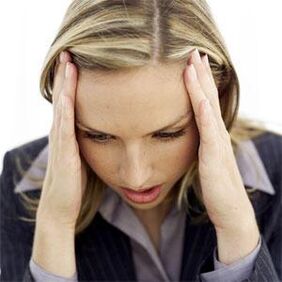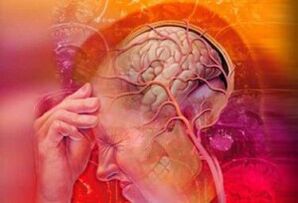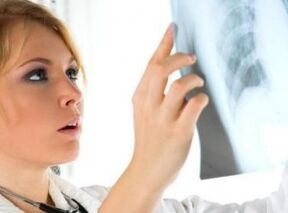Osteochondrosis today is rightly considered a "disease of the century", since most often people suffer from people whose work does not require increased motor activity.
In most cases, changes in cartilage and bone tissue are observed in people of working age - up to 40 years.
The disease can affect different parts of the spine, and the second most preparing is osteochondrosis of the cervical region.
What is it?
Osteochondrosis is a dystrophic disorders of the articular cartilage and adjacent bone tissue.
Previously, the term extends to a large group of bone-acting diseases, but is now only used in degenerative spinal disease.

Compared to other spine departments, the cervical region is the most movable and has many nerve and vascular formations.The structure of the vertebrae is small in size, as well as the fact that they are surrounded by a rather weak muscle corset.
Such anatomical structure predisposes to the development of osteochondrosis, the severity of the clinical manifestations of which depends on the nature of the changes in the intervertebral discs and the degree of destruction.
The causes of the development of the disease
The main and most common cause of osteochondrosis of the cervical spine is a sedentary lifestyle.
Due to the lack of exercise with a sedentary and seated lifestyle:
- Metabolic processes are impaired;
- The level of salts in the blood and lymphatic fluid increases;
- Salts are applied to the cervix, in the kidney and liver.
The damage to the cervical vertebrae is mainly determined by a lack of nutrients in intervertebral discs.Therefore, the main causes of cervical osteochondrosis also include improper and unbalanced diet.
Risk factors
There are many risk factors for cervical osteochondrosis.

The most common factors are:
- heredity;
- Age -related changes;
- injuries to the cervical spine;
- hypothermia;
- hormonal disorders that lead to metabolic disorders;
- Some autoimmune diseases that lead to cartilage tissue damage (systemic lupus erythematosus, rheumatism).
What is dangerous
Not only the spinal cord and the roots of the nerves pass through the cervical spine, but also the spinal artery, which is responsible for the supply of blood to the back of the brain, the brain and cerebral brain.
Therefore, in cervical osteochondrosis, this artery is squeezed and as a result of this disorder of cerebral circulation.
In particularly advanced cases, the pressure of the artery and adjacent blood vessels and nerve plexus can lead to such consequences that:
- coordination violation;
- hearing and vision reduction;
- A blow.
If you do not cure the disease at the initial stage, it can lead to such complications as: the convexity of the intervertebral disc or hernia on the intervertebral disc.
The degree of development of the disease
Cervical osteochondrosis, such as osteochondrosis of another spine, develops in stages.There are 3 stages of disease development.
1 degree
It is characterized by the beginning of the destruction of the intervertebral discs.
Quaders are formed in the fibrous ring, strength and elasticity of the disc are formed, its height decreases, which is why the nerve roots are pressed.
Characteristic diseased pain occurs.Sometimes in stage 1 (preclinical) such pain can be absent and osteochondrosis occurs with moderate neck discomfort.
2 degrees
If osteochondrosis of the 1st degree is not treated or treatment is not effective, then a chronic condition occurs, which is the second degree of osteochondrosis.
The pain becomes constant, the destruction and seal of the intervertebral disc is continuing and leads to small dislocations of the cervical vertebrae.
With cervical osteochondrosis at this stage can develop a falling head syndrome.This syndrome is characterized by severe pain and a person is forced to keep his head in a fixed state to reduce pain.
3 degrees
Cervical osteochondrosis of grade 3 is accompanied by the following signs:
- headache;
- nausea;
- dizziness;
- cervical "bastards";
- Disruption of upper limb sensitivity.
The fibrous ring is already almost destroyed, leading to complications of osteochondrosis - a convexity of the intervertebral disc or intervertebral hernia.
At 3 stages of osteochondrosis, the intensity of pain may decrease as the affected cartilage tissue in the intervertebral disc simply does not exist, which means that there is no source of pain, but the pinching of the nerve roots remains so that the pain does not leave completely.
Characteristic characteristics and symptoms
There are many signs of manifestation of this disease.And they depend on which vertebrae are damaged by this disease.

The characteristic cervical osteochondrosis syndromes are:
- Spine syndrome;
- Spinal artery syndrome;
- Cervical migraine syndrome;
- Hypertension Syndrome.
All of these syndromes are accompanied, first of all, different types of pain.
If we look at spinal artery syndrome, then the headache here manifests itself in the early stage of the development of the disease.
At the same time, pain attacks can be accompanied by:
- dizziness;
- shaking a hike;
- Visual symptoms (the appearance of fog in front of the eyes, reduction of visual acuity, etc.).seizure (with sharp head movements).
In hypertension syndrome, increased intracranial pressure is determined.
Headache is more cracking, can be accompanied by nausea and vomiting.With exacerbation of cervical osteochondrosis, an increase in temperature and an increase in ESR can be observed.
When compressing spinal roots ("Roying Syndrome"), the following neurological symptoms may occur:
- pronounced neck pain (cervikagia);
- neck pain, spread in the forearm and shoulder bone (cervikobrachial);
- hand pain;
- sensations of crunching or cod in the neck when turning the head;
- The pain of "giving" the ear, which occurs only after a long stay in an uncomfortable position or a sharp movement;
- pain or feeling of coma in the throat, respiratory disorders;
- numbness of the hands and tongue;
- sensation of swelling of the tongue;
- pronounced weakness;
- violation of hearing and vision;
- tinnitus;
- General worsening in the well.
Cervical migraine syndrome is irritated by the sympathetic nodes, leading to impaired reactivity of the vessels of the brain and blood disorders.

As a result, hypertension may develop, often accompanied by:
- ears with congestion;
- tachycardia;
- noise in the head;
- Calling in the ears.
When compressing the blood supply to the spinal cord of the arteries, a spinal stroke may occur.
Blooding in the brain with osteochondrosis can lead to:
- oxygen insufficiency of brain cells;
- Mental disorders (a state of depression, panic attacks);
- The appearance of signs of episode, such as short -term losses of consciousness and tension of the whole body - is often confused with signs of epilepsy.
A similar sign of cervical osteochondrosis, such as changes and rhythm of the heart, such as extrasystole or arrhythmia, is very common.
Such signs are very common among drivers and office workers.
Due to the sedentary lifestyle in the intervertebral dishes of the cervical and thoracic spine, changes occur that lead to disorders in the heart.
In most cases, while osteochondrosis is cured, it will be practically impossible to get rid of disorders in the rhythm of the heart.
Swelling under the eyes may also show osteochondrosis of the cervical region.
Most often, they depend on the position of the head through the night's sleep, pass throughout the day and combine with headaches, dizziness, heaviness in the head, etc.
Vegeta -vascular dystonia is another of the common diseases that occur in this disease.
This is a consequence of the pinching of the vascular arteries that pass from the side of the spine.
Diagnostic methods
A preliminary diagnosis was detected during the initial examination of the patient.Most recently, the doctor had to diagnose after performing only an external examination of the patient and sending it to X -ray.
But, unfortunately, in X -ray it is impossible to see a complete picture of the development of the disease.

There are currently such examinations such as computed tomography and magnetic resonance imaging are available, with which you can fully evaluate what stage of development the disease is.
After diagnosis, the patient goes to the doctor who specializes in this area.
Which doctor treats?
A specialist in the narrow orientation deals with treatment - vertebolog or vertebrae.
Treatment of cervical osteochondrosis
The basis for the treatment of cervical osteochondrosis is the severity of the main clinical symptoms.
In the cervical region, the symptoms are mainly associated with the pressure of the blood vessels and nerve endings, so during treatment the edema is relieved mainly and the bloodstream is restored.
There are many treatments used in the treatment of osteochondrosis of the cervical spine.
The most effective treatment is complicated, which is a combination of several conservative methods of treatment.
The complex treatment of cervical osteochondrosis may include the following traditional and non -traditional methods: drug treatment, massage, acupressure, manual therapy, physiotherapy, acupuncture, homeopathy, folk remedies and more.
The stages of treatment of osteochondrosis are the same for all locations of this disease:
- You must first remove the pain syndrome.
- Then the edema will be removed.
- At this stage, it is necessary to normalize blood circulation.
- Strengthening the muscle corset.
- Improving nutrition and tissue regeneration.
Only the team of good specialists, including a neurologist, physiotherapist, massage therapist, surgeon, preterior, can choose the most appropriate therapy.
Like any disease, treats osteochondrosis of the cervical region in a very early stage of occurrence.If you do not start the process, at this stage you can achieve a complete cure of osteochondrosis.
Unfortunately, 2 and 3 stages of cervical osteochondrosis are accompanied by the complete or partial destruction of the intervertebral discs, so these stages are characterized by a very long recovery process.
First aid
How to relieve pain from exacerbation?
With severe pain, you should take anesthesia from a home medicine cabinet.You can also glue pepper patches with pain.
When edema occurs, diuretics can be taken.Rubbing the neck area with painkillers can help.
Medical physical education in exacerbation is contraindicated, as well as heating, as these influences can cause serious complications.
After removing acute pain, you should urgently consult your doctor for consultation.
Medication
Medicines most often start with injections (with exacerbation), then switch to tablets and candles in combination with local use of ointments and gels.
Anesthesia in drug treatment is performed with the help of steroid anti -inflammatory drugs.
Be sure to prescribe medicines that restore cerebral circulation.
With pathological muscle tension, muscle relaxants can be prescribed, such as average Calm.Vitamins in therapeutic doses and trace elements are taken for more effective treatment.
In the case of intervertebral hernia, surgery is not rarely recommended and the attending physician may offer surgery.
Massage and self -massage
This method goes well with physiotherapy and physiotherapy.You can take a massage course both at any medical institution and to private practices.
Massage is necessary to strengthen cervical osteochondrosis to strengthen the muscles and to relieve tension in the neck.
The task of the massage therapist is to eliminate the harmful products of metabolism, as well as to relieve the spasm from the pathological zone by increasing the flow and flow of blood in the area of inflammation.
The main techniques used by specialists during the neck massage are:
- Gaul;
- pressing;
- TRIPING;
- vibration;
- kneading.
The self -assessment technique can be implemented using the following techniques:
- Repayment (movements should be soft without much effort to form folds);
- Mixing (deep effect on the muscles, by capturing in folding, pressure and pressing -ups);
- vibration (oscillator effects by shading, shaking, tapping).
Self -massage should always be completed by caressing.You can use a massager during the vibration.
Supreme massage
Excess massage relieves headache by exacerbation of cervical osteochondrosis, helps with pressure jumps, normalizing it.
Acupressure scheme:
- The impact on the Feng Fu point, which is located under the back of the hill, for 1 minute.
- The impact on the point of a fan-chi, located on the width of two fingers from the special processes of the skull.
- Exposure for 1-1.5 minutes on the point of I-MEN (located at a distance of three fingers width from the point of Fen-Fu).
- The sedative exposure is 1-1.5 minutes at the dowel point (7th cervical vertebra).
After acupressure, it is necessary to lie down for a few minutes as a little dizziness may occur.
Manual therapy
Manual therapy helps to cope with both acute and chronic pain, also increases the volume of movements and improves posture well.
The basic techniques of manual therapy for osteochondrosis of the cervical spine:
- Relaxing and segmental massage.It is used to heat the muscles and relieve tension.
- Mobilization.Impacts aimed at restoring joint functions.The grip method.
- Manipulation.Acute impetus aimed at the patient's pathological areas.The procedure is accompanied by a characteristic crisis (return of the joint to a normal position).
A specialist practicing manual therapy should perfectly have these techniques.Otherwise, any error can lead to injuries.
Acupuncture
Acupuncture contributes to the release of cortisol into the blood.This hormone has a pronounced anti -inflammatory effect.

Acupuncture is performed by exposing points near the inner edge of the scapula.The needles are introduced to a depth of 1 - 2 cm and left for exposure to 10 - 30 minutes.
Homeopathy
Treatment with drugs brings with it many side effects so that homeopathy can become a worthy substitute for treatment without unwanted consequences.
With cervical osteochondrosis with pronounced hypertension (expressed by pain in the back of the head), strontium carbonate is used.
Assign 3, 6, 12 and 30 reproduction.
Dietary characteristics
Food should be saturated with calcium and magnesium.
These trace elements are located in fish and seafood, in nuts, legumes and dairy products.
Often, osteochondrosis of the neck can be accompanied by atherosclerosis.In this case, a severe diet is recommended.
The diet is prescribed for 3-4 months.It is necessary to limit the consumption of all cholesterol -containing products.These include animal fats, fatty varieties of meat, fatty dairy products and more.Also, the consumption of salt, sugar, flour products should be restricted or excluded.
It is recommended to give up bad habits (smoking, alcohol, etc.).
Cervical osteochondrosis and alcohol are interconnected.The fact is that when it falls into the blood, alcohol destroys the cells, thus impairing the already impaired blood circulation for osteochondrosis.
Therefore, it must be limited to a minimum during the period of exacerbation in order to completely refuse the use of alcohol.
Prevention
In order to prevent osteochondrosis of the uterus, the following rules are recommended:
- Sleep should be on a hard mattress and low pillow: the angle of flexion of the neck should not be more than 15 degrees;
- Take a hot shower every day for at least 10 minutes;
- Visit sauna and bath as often as possible: it strongly helps to remove neck spasms;
- Let's be aerobic loads and regular low -rate walks;
- Participate in swimming;
- After 25 years, avoid impact loading of the spine (jumping, running);
- When sitting, be sure to take five minutes of breaks every hour;
- Regular yoga classes can prevent any manifestations of cervical osteochondrosis;
- Refuse to visit the gym as bodybuilding hours can cause a convexity of the cervical disc;
- Exercise as a prevention for osteochondrosis of the neck helps to strengthen the cervical muscles, relieve tension.
Frequently asked questions
What should I do during pregnancy and how to treat it?
Often during pregnancy, the first symptoms of cervical osteochondrosis occur.
This is due to the change in the hormonal background and the softening of the vertebrae, as well as the displacement of the center of gravity and excessive loading of the spine.
Treatment of osteochondrosis in pregnant women is quite complicated as it is limited mainly by the method of drugs aimed at stopping pain.
You can use natural ointments or resort to folk medicine.
Any effects on the neck area (heating, charging, etc.) are strictly prohibited during pregnancy.
Does children and adolescents happen?
In children and adolescents, cervical osteochondrosis develops due to congenital or acquired functional cartilage deficiency.
It is expressed by complaints of headache, rapid fatigue, dizziness and seizures.
Is it possible to warm the neck area?
The neck warning with cervical osteochondrosis is strictly forbidden, especially at the stage of exacerbation of the disease, as warming can lead to an increase in edema and enlargement of the vessels of the brain.
How to sleep properly?
You should sleep on a flat, solid bed with an orthopedic mattress.
The recommended and most comfortable position lies on the side when the shoulder rests on the mattress and the head rests on a small pillow.

The use of an orthopedic pillow helps to relax the muscles in the cervical region, reduces irritation of nerve endings, which prevents headaches and insomnia.
Are physical activity allowed and the bathroom?
For preventive measures and in the 1 stage of cervical osteochondrosis, it is recommended to deal with physiotherapy exercises and swimming.
It is strictly forbidden to lift weights, hard work, classes in the gym.
A visit to the bathroom and a sauna is also recommended only to prevent cervical osteochondrosis and in the early stages of the disease.
























